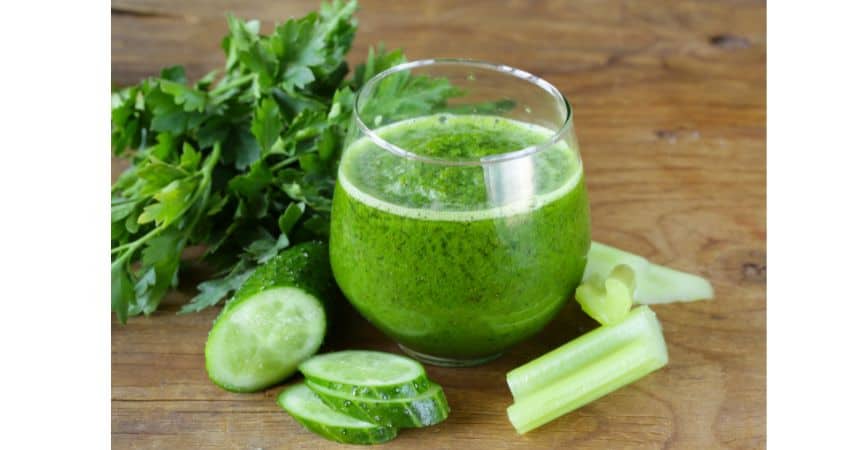Spinach Juice Benefits: Unlocking the Nutritional Powerhouse
Many of my clients ask about healthy benefits of juice including spinach juice. Let’s take a close look at the answer.
Spinach juice benefits include a wide variety of vitamins and minerals. The highest percentages include vitamin A, vitamin C, vitamin K, folate, potassium, magnesium, calcium and iron. Also, the juice contains much fiber and chlorophyll which may have beneficial antioxidant properties.
This article will breakdown each nutrient and how they benefit health. In addition, I’ll include which is the best type of spinach to consume for maximum benefits.
Nutritional Profile of Spinach Juice

As a Certified Health Coach, many clients ask about spinach juice benefits. I consume it almost daily and believe it is highly beneficial to my nutrient plan. Therefore, I have researched this topic before and while writing this article. Let’s start with the nutrients.
Spinach juice is renowned for its dense nutritional composition, encompassing a wide spectrum of vitamins, minerals, and bioactive compounds. This beverage serves as an exceptional means to deliver these nutrients in a concentrated and bioavailable form.
Vitamin and Mineral Richness
Spinach juice is a potent source of vitamin A, with a single cup providing approximately 63% of the daily value (DV).
It is also rich in vitamin K, essential for bone health and blood clotting.
Significant levels of vitamin C and folate further enhance its profile, contributing to immune function and cellular health.
The presence of minerals such as potassium, magnesium, and calcium is notable, with potassium assisting in blood pressure regulation and magnesium playing a vital role in numerous enzyme reactions.
The mineral iron is also abundant, which is crucial for oxygen transport in the blood.
- Vitamin A: 63% DV
- Vitamin C: High levels. 100 grams of raw spinach contains 28 mg.
- Vitamin K: Substantial amounts. 100 grams of raw spinach contains 483 mcg.
- Folate: Considerable amounts. 100 grams of raw spinach contains 194 mcg.
- Potassium: Helps in blood pressure regulation
- Magnesium: Vital for enzyme reactions
- Calcium: Supports bone health
- Iron: Essential for oxygen transport
Fiber and Antioxidants Content
The fiber content in spinach juice can aid in blood sugar regulation, helping to prevent spikes after meals. Fiber also supports digestive health by promoting regular bowel movements.
Spinach juice is a treasure trove of antioxidants such as beta-carotene, vitamin E, and chlorophyll, which may offer cell protection and may support the body’s defense against inflammatory diseases.
These antioxidants work in concert to help protect the body’s tissues from oxidative stress, which can lead to chronic illness.
- Fiber: Aids in regulating blood sugar
- Beta-carotene and Vitamin E: Powerful antioxidants
- Chlorophyll: May have beneficial antioxidant properties
The balance of these nutrients makes spinach juice an excellent choice for those seeking to enhance their dietary intake with a healthful drink.

Disclaimer: Some links in this article are affiliate links which means I may earn a small commission at no extra cost to you. As an Amazon associate and eBay partner I earn from qualifying purchases.
Integrating Spinach Juice into Your Diet
It’s important to know the optimal way to prepare this nutritious beverage to maximize its potential.
Best Way to Make Spinach Juice
To make spinach juice more beneficial, one should use a juicer or a blender. A masticating juicer is ideal as it slowly crushes the leaves and extracts the juice while preserving the nutrients.
Masticating juicers are better than high speed traditional ones. There are many affordable ones on Amazon here, masticating juicers.
For those opting for a blender:
- Start by adding a handful of spinach to the blender.
- Incorporate other hydrating vegetables like cucumber and celery for added nutrients and richness in flavor.
- Enhance the taste and vitamin C content by including lemon, kiwi or apple.
- If a sweeter juice is preferred, consider blending in a slice of pineapple.
Check the consistency after blending. If the juice is too thick, one can add a small amount of water or milk of choice to achieve the desired texture.
I used a Vitamix blender. Check out my article review, Vitamix Venturist Review.
Recipe tip for increased benefits:
To complement the spinach and amplify the nutritional profile, include a mix of leafy greens such as kale, along with fruits, or even carrots for a sweeter taste and beta-carotene boost.
Remember to strain the juice through a mesh strainer if a smooth texture is desired, especially when using a blender, as this will remove excess pulp.
For individuals without a juicer or blender, pre-made spinach juice is often available at health food stores, yet one should be mindful of added sugars and preservatives.
It’s best to avoid the juice isle of the supermarket and visit the refrigerated section close to the produce area.
Frozen or Fresh: Does it Matter?
When it comes to the benefits of spinach juice, one may wonder if using frozen or fresh spinach makes a difference.
Both forms of spinach contain antioxidants and phytochemicals like carotenoids and flavonoids, which are beneficial for overall health. They also provide essential vitamins and minerals.
Fresh Spinach:
- Contains more folate compared to its frozen counterpart.
- Offers a crisper texture and more vibrant flavor.
- Ideal for salads and sautés due to better retention of texture and flavor when cooked.
Frozen Spinach:
- More affordable, averaging $0.12 per ounce, as opposed to $0.16 for fresh.
- Delivers a milder flavor and softer texture after being cooked.
- Requires less volume; 10 ounces of frozen spinach is roughly equivalent to 16 ounces of fresh spinach once cooked.
If you have any questions to ask me about this article, don’t hesitate to comment below or email us. You can find an email on our contact page.
Read More Spinach Articles
Kale vs Spinach: Which is Better? A Complete Comparison
Article Resources:
- USDA: Spinach, raw
- NIH: Antioxidant Effects of Spinach
